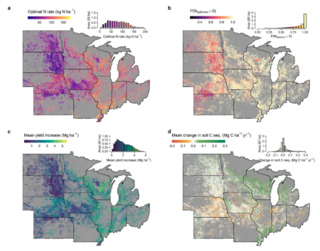Boosting climate change mitigation potential of perennial lignocellulosic crops grown on marginal lands
R.A. Martinez-Feria and B. Basso "Boosting climate change mitigation potential of perennial lignocellulosic crops grown on marginal lands" Environmental Research Letters 17 (2022) [DOI: 10.1088/1748-9326/ac541b]
Nitrogen fertilizer (NF) is a major uncertainty surrounding the greenhouse gas (GHG) emissions of lignocellulosic biofuels. NF enhances agronomic yields and soil C inputs via plant litters, but results in soil organic carbon (SOC) decomposition, soil N2O fluxes, and a large fossil energy footprint. Thus, whether NF is beneficial or detrimental to the GHG mitigation of biofuels is unknown. Here, we show the potential GHG mitigation of fertilizing switchgrass (Panicum virgatum) at the NF rate that minimizes net GHG emissions across 7.1 million ha of marginal lands in the Midwest US, with long-term production advantages surpassing emitted GHG by 0.66 Mg CO2e ha−1 yr−1 on the aggregate. Marginal lands limited by poor N fertility could see a much greater benefit, but not SOC-rich lands, limited by low precipitation, or short growing seasons. The objectives of maximizing yield and minimizing GHG overlap only in a few environments, suggesting that maximum yield will reduce the climate benefit of cellulosic biofuels.
R code and the database needed to run the developed GBM emulators can be found on Zenodo.
